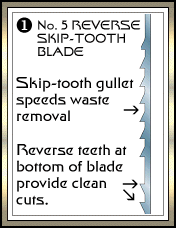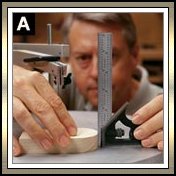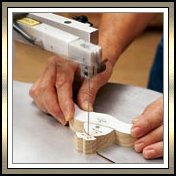 ❈ Intarsia Tips and TricksFor intarsia projects to look their best, the parts need to fit together tightly. Besides sawing right down the middle of the pattern lines, what else can you do to prevent gaps? These surefire pointers from Judy Gale Roberts and Jerry Booher could improve your results dramatically.1. Use the right blade For scrollsawing softwoods and hardwoods up to 1" thick, Judy and Jerry recommend you use a no. 5 reverse skip-tooth blade (12 teeth-per-inch minimum) like the one shown on Drawing 1. With its set of reverse teeth at the bottom, the blade cuts on both the up and down strokes, leaving a smooth finish and minimizing bottom splintering. The blade's quick cutting action also allows you to scrollsaw slower for better control. For cutting woods up to 1-3/4" thick, use a more aggressive no. 7 blade (10 teeth-per-inch minimum). |
 2. Square your table 2. Square your tableAfter tensioning the blade in your scrollsaw, check that the table is square to it, as shown in Photo A. Adjust the table's tilt as necessary to square it. Cut a curve in 1"-thick scrap, and check the edge for square. The curve makes it easy to see any light between the square and the edge. 3. Set the right speed for control To cut accurately, you need to set a speed that gives you good control. As a general guideline, Jerry suggests setting the speed at 60-70% of your saw's maximum speed. The optimum speed, though, will vary depending on the density of the material. So, make test cuts in scrap first to find the right setting. |
 4. Plan before cutting 4. Plan before cuttingBefore you rush into cutting parts, plan how you can cut them from larger pieces for safe handling. Aim for rough-cutting parts or groups of parts into hand-size pieces, and shape and separate the small parts from the group first, as shown in the this photo. 5. Check the bottom of parts for splintering Even when using the right blade, you can still get splintering. Those splinters can lead to out-of-square workpiece edges by preventing your stock from lying flat on the table. So, frequently check the bottom for splinters, and sand them off. Content Copyright © WOOD Magazine |

